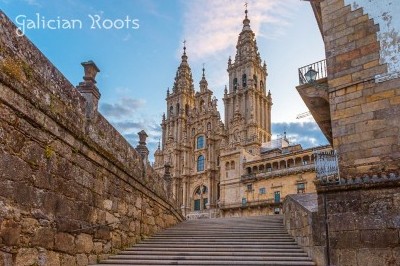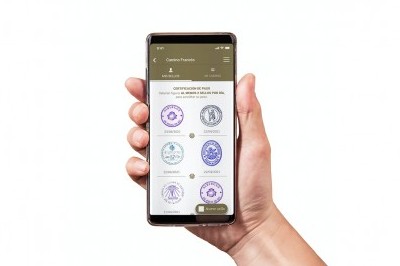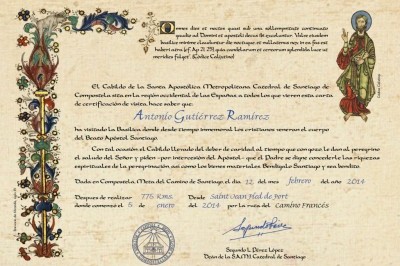Welcome to the bicigrino club! If you are reading this the idea of completing the Camino de Santiago pedalling prowls your mind. You are close to becoming a pilgrim by bike and join the select group of people that get to the Plaza del Obradoiro on two wheels.
Even though many more pilgrims are doing the Camino de Santiago by bike, the number remains rather small. In fact, statistics of 2018 confirm it: bicigrinos represent only 6%of the total amount of pilgrims. We suspect there is a belief that this modality is only suitable for expert cyclers and athletes with steel legs and thousands of kilometres behind. Nothing could be more untrue; any healthy person can do the Camino de Santiago by bike. We won’t deny that you will need training and some habit, but not much more than you would need to do it on foot.
To the experienced cyclists some advice we can give you that you don’t know already but for those bicycle amateurs at Galician Roots we have a few recommendations that can be useful, starting by solving some basic questions that arise prior embarking on the Camino. If applying for the Compostela is one of your objectives you must know that it is necessary to complete at least 200 kilometres, 100 more than if you do it walking. Therefore, if you choose the French Way your starting point should be located in Ponferrada (León) at least. To certify your journey, you need to get two daily stamps per day on your pilgrim passport, which is exactly the same for the rest of pilgrims.
We are often asked if the stages of the Way of Saint James by bike are the same as those done on foot. Overall we would say yes, although it is true that the stages are illustrative and the only thing that is formally set are the towns you pass by during the path. At Galician Roots we suggest you, here more than elsewhere, to plan your itinerary and adapt each stage and distance to your needs and your experience with the bike. Many relevant factors play a role; not only your physical condition but also the terrain conditions. There are stony stretches, steep ones or others that go through the mountains that have an alternative along the road far more bearable. Also keep in mind that bikes offer increased mobility which will allow you, if you wish, to visit monuments and places of interest that are distant from the Jacobean path and that are worth it. This is something you need to assess when planning the stages as well as the weather conditions: the stretch in perfect condition that you could do tomorrow could turn into a blocked muddy place with today’s rain.
The Camino de Santiago will welcome you at any time of the year, but there are periods easier than others, especially if you are biking. The best thing is to do it between May and September, both included, and avoid the rainy season. Getting wet is tedious but more cumbersome is the path getting wet. The pilgrim by bike needs to think for both: himself/herself and his/her bicycle. Furthermore, when choosing the best season to do your Camino de Santiago by bicycle you must keep in mind another factor unknown for many: the pilgrims on foot have the preference above all, so it will be your obligation to be aware of their presence, avoid them, yield the way and pass carefully. In public hostels also they usually have priority until 8 p.m., as they tend to arrive exhausted even if they have done half the kilometres you did. Considering the above, it is probably not a great choice to venture on doing the French Way during July or August months with hundreds of pilgrims walking the way and appearing at each kilometre upon your path…
In foot or by bicycle, with more or fewer privileges, a common requirement for every pilgrim is to acquire a minimum level of fitness before you begin your adventure. Don’t worry, this is not the Tour de France, on the Camino you decide the pace, the number of kilometres per day and the number of days into the tour. To give you an idea of the physical effort required by the itinerary, we will take as a reference the French Way, that together with the English Way are the preferred ones by pilgrims travelling by bicycle and besides these are two itineraries with an orographic outline with fewer difficulties. The French Way by bike has 773 kilometres from the French town of Saint Jean Pied de Port to Santiago de Compostela and usually takes 15 stages, which requires an average of 52 kilometres per day. This is a good reference to take into account for your training during the previous months. Ideally when you practice is to load your bike with 5 to 10 extra kilos, as during the journey you will take your home with you and even if the weight is not very much, this affects when fatigue appears, especially on the climbs, where you feel someone grabs you and you don’t progress.
Accordingly, with what we just outlined, you will deduce that it is always better to bring the smallest amount of luggage. True, but do not exaggerate. Bringing low weight can be counter-productive, in addition to our luggage the bicycle itself has its own weight and there are some key elements that you need to bring. Besides the common advice for any pilgrim, the pilgrim on a bicycle can’t forget to bring cycling shorts and short and long sleeved cycling jerseys to use depending on the climate, waterproof garments and of course the helmet. For the bicycle (you need to think for both) you can’t forget a spare tyre, a patch kit, an air pump, grease and a multi-purpose tool for cyclist mechanicals. You may also include a bicycle lock and a front and back light. With all this material, the garments and the personal care products you shouldn’t exceed 12 kilos of luggage in any circumstances. The saddlebags and panniers will be enough to fit everything so that your back is weight free.
Finally, we allow ourselves to give you some basic pieces of advice regarding the type of bicycle. The most commonly used by pilgrims is the mountain bike, with front suspension. It’s suitable for dirt roads, those predominant in the Jacobean route, but its versatility also allows it to adapt properly to mountain areas, stony roads and asphalt roads. If you are looking for extra comfort then the mountain bike with full suspension is the ideal option, especially if you are thinking of doing more than 50 kilometres per day. The main drawback is the price since they are significantly more expensive than the previous ones. Hybrid bikes are another option to take into consideration but when the ground is too uneven they may not offer the best performance. Regarding the road bikes, they are the best to load clothes and luggage, as they are prepared to carry luggage racks and saddlebags in the front and rear wheels and even in the handlebars. They are comfortable as they allow you to be in an upright position, however, they are not the cheapest and they don’t adapt to any surface.
In any case, don’t be worried about the price. There is no reason that will deprive you of reaching your goal; the grave of the Apostle Santiago. The bike rental on the Camino de Santiago is very common nowadays, although it may not appear, it is cheaper than buying a new bicycle and, of course, a more comfortable alternative. You will avoid the bothersome process of disassembling and packing the bike, sending it to the starting point, assembling it again and repeating all the process once you return home. Neither shall you be concerned by the necessary planning and management of the stages day to day. Remember that you will always find someone to do these tedious tasks while you don’t have time or knowledge to spend on it. Booking the Camino de Santiago by bike with a travel agency such as Galician Roots it to place yourself in the hands of professionals so that your only concern is to enjoy the experience, which is a great deal!
At Galician Roots we offer several tours of the Camino de Santiago by bike, check all our suggestions here:
https://www.galicianroots.com/en/viajes/el-camino-de-santiago/el-camino-de-santiago-en-bicicleta.htm
Besides we also organise personalised tours of the Way of Saint James by bike, we handle the bike rental during all the trip, the reservation of the accommodations, the luggage transfer and many other services useful along your journey. Do not hesitate to contact us and we will work on a customised budget and tour!
Even though many more pilgrims are doing the Camino de Santiago by bike, the number remains rather small. In fact, statistics of 2018 confirm it: bicigrinos represent only 6%of the total amount of pilgrims. We suspect there is a belief that this modality is only suitable for expert cyclers and athletes with steel legs and thousands of kilometres behind. Nothing could be more untrue; any healthy person can do the Camino de Santiago by bike. We won’t deny that you will need training and some habit, but not much more than you would need to do it on foot.
To the experienced cyclists some advice we can give you that you don’t know already but for those bicycle amateurs at Galician Roots we have a few recommendations that can be useful, starting by solving some basic questions that arise prior embarking on the Camino. If applying for the Compostela is one of your objectives you must know that it is necessary to complete at least 200 kilometres, 100 more than if you do it walking. Therefore, if you choose the French Way your starting point should be located in Ponferrada (León) at least. To certify your journey, you need to get two daily stamps per day on your pilgrim passport, which is exactly the same for the rest of pilgrims.
We are often asked if the stages of the Way of Saint James by bike are the same as those done on foot. Overall we would say yes, although it is true that the stages are illustrative and the only thing that is formally set are the towns you pass by during the path. At Galician Roots we suggest you, here more than elsewhere, to plan your itinerary and adapt each stage and distance to your needs and your experience with the bike. Many relevant factors play a role; not only your physical condition but also the terrain conditions. There are stony stretches, steep ones or others that go through the mountains that have an alternative along the road far more bearable. Also keep in mind that bikes offer increased mobility which will allow you, if you wish, to visit monuments and places of interest that are distant from the Jacobean path and that are worth it. This is something you need to assess when planning the stages as well as the weather conditions: the stretch in perfect condition that you could do tomorrow could turn into a blocked muddy place with today’s rain.
The Camino de Santiago will welcome you at any time of the year, but there are periods easier than others, especially if you are biking. The best thing is to do it between May and September, both included, and avoid the rainy season. Getting wet is tedious but more cumbersome is the path getting wet. The pilgrim by bike needs to think for both: himself/herself and his/her bicycle. Furthermore, when choosing the best season to do your Camino de Santiago by bicycle you must keep in mind another factor unknown for many: the pilgrims on foot have the preference above all, so it will be your obligation to be aware of their presence, avoid them, yield the way and pass carefully. In public hostels also they usually have priority until 8 p.m., as they tend to arrive exhausted even if they have done half the kilometres you did. Considering the above, it is probably not a great choice to venture on doing the French Way during July or August months with hundreds of pilgrims walking the way and appearing at each kilometre upon your path…
In foot or by bicycle, with more or fewer privileges, a common requirement for every pilgrim is to acquire a minimum level of fitness before you begin your adventure. Don’t worry, this is not the Tour de France, on the Camino you decide the pace, the number of kilometres per day and the number of days into the tour. To give you an idea of the physical effort required by the itinerary, we will take as a reference the French Way, that together with the English Way are the preferred ones by pilgrims travelling by bicycle and besides these are two itineraries with an orographic outline with fewer difficulties. The French Way by bike has 773 kilometres from the French town of Saint Jean Pied de Port to Santiago de Compostela and usually takes 15 stages, which requires an average of 52 kilometres per day. This is a good reference to take into account for your training during the previous months. Ideally when you practice is to load your bike with 5 to 10 extra kilos, as during the journey you will take your home with you and even if the weight is not very much, this affects when fatigue appears, especially on the climbs, where you feel someone grabs you and you don’t progress.
Accordingly, with what we just outlined, you will deduce that it is always better to bring the smallest amount of luggage. True, but do not exaggerate. Bringing low weight can be counter-productive, in addition to our luggage the bicycle itself has its own weight and there are some key elements that you need to bring. Besides the common advice for any pilgrim, the pilgrim on a bicycle can’t forget to bring cycling shorts and short and long sleeved cycling jerseys to use depending on the climate, waterproof garments and of course the helmet. For the bicycle (you need to think for both) you can’t forget a spare tyre, a patch kit, an air pump, grease and a multi-purpose tool for cyclist mechanicals. You may also include a bicycle lock and a front and back light. With all this material, the garments and the personal care products you shouldn’t exceed 12 kilos of luggage in any circumstances. The saddlebags and panniers will be enough to fit everything so that your back is weight free.
Finally, we allow ourselves to give you some basic pieces of advice regarding the type of bicycle. The most commonly used by pilgrims is the mountain bike, with front suspension. It’s suitable for dirt roads, those predominant in the Jacobean route, but its versatility also allows it to adapt properly to mountain areas, stony roads and asphalt roads. If you are looking for extra comfort then the mountain bike with full suspension is the ideal option, especially if you are thinking of doing more than 50 kilometres per day. The main drawback is the price since they are significantly more expensive than the previous ones. Hybrid bikes are another option to take into consideration but when the ground is too uneven they may not offer the best performance. Regarding the road bikes, they are the best to load clothes and luggage, as they are prepared to carry luggage racks and saddlebags in the front and rear wheels and even in the handlebars. They are comfortable as they allow you to be in an upright position, however, they are not the cheapest and they don’t adapt to any surface.
In any case, don’t be worried about the price. There is no reason that will deprive you of reaching your goal; the grave of the Apostle Santiago. The bike rental on the Camino de Santiago is very common nowadays, although it may not appear, it is cheaper than buying a new bicycle and, of course, a more comfortable alternative. You will avoid the bothersome process of disassembling and packing the bike, sending it to the starting point, assembling it again and repeating all the process once you return home. Neither shall you be concerned by the necessary planning and management of the stages day to day. Remember that you will always find someone to do these tedious tasks while you don’t have time or knowledge to spend on it. Booking the Camino de Santiago by bike with a travel agency such as Galician Roots it to place yourself in the hands of professionals so that your only concern is to enjoy the experience, which is a great deal!
At Galician Roots we offer several tours of the Camino de Santiago by bike, check all our suggestions here:
https://www.galicianroots.com/en/viajes/el-camino-de-santiago/el-camino-de-santiago-en-bicicleta.htm
Besides we also organise personalised tours of the Way of Saint James by bike, we handle the bike rental during all the trip, the reservation of the accommodations, the luggage transfer and many other services useful along your journey. Do not hesitate to contact us and we will work on a customised budget and tour!
Blog
More news











